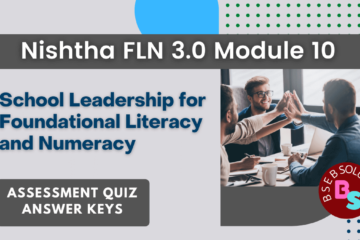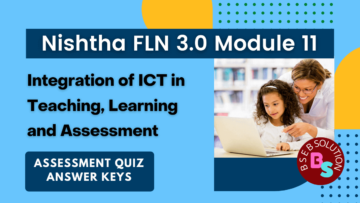The course is designed to introduce the purpose and transaction process of Vidya Pravesh (school preparation module for initial three months of Grade-I) and Balvatika programme (one year programme before Grade-I), which are meant to prepare children with cognitive and linguistic competencies that are pre-requisite for learning to read, write and develop numbe r sense through a play-based approach. In this post you will be able to know AR, UP, UK, MZ, NL, OD, PB, AP, AS, BH, GJ, HR, HP, JK, JH, KA, MP, CHD, CG, DL, GA, MH, CBSE, KVS, NVS, MN, ML, RJ, SK, TS, TR, Nishtha FLN 3.0 Module 5 Understanding ‘Vidya Pravesh’ and ‘Balvatika’ Quiz question and Answer Key PDF in English for Primary School Teachers of all states. यदि आप यह प्रश्नोत्तरी हिन्दी में पढ़ना चाहते हैं, तो यहाँ क्लिक करें |
Nishtha FLN 3.0 Module 5 “Understanding ‘Vidya Pravesh’ and ‘Balvatika’” Answer Key
The assessment questionnaire of Nishtha 2.0 and 3.0 training is the same in all states, but the Training Links are different. Out of around 40 questions, you will get only 20 random questions in an attempt. You will be able to get the certificate by scoring 70% marks in maximum three attempts.
All the Nishtha trainings available on Diksha App are design to improve teacher performance. So, take all the training seriously and solve the assessment quiz at the end. Certificate will issued only after securing 70% marks in the evaluation quiz. If you face any kind of problem in solving Nishtha FLN 3.0 Module 5 “Understanding ‘Vidya Pravesh’ and ‘Balvatika’” Quiz then get complete solution here.
Nishtha FLN 3.0 Module 5 Answer Key
Q. 1: What is a portfolio?
- Collection of toys and learning material
- Record of personal profile of each child such as admission, health, etc.
- Collection of concrete work sample of each child
- Record of punctuality of each child to the school
Q. 2: The main purpose of the activity/interest areas is to give children opportunity for
- Free play
- Standing
- Sitting
- Rest
Q. 3: NEP-2020 advocates that learning of children should be in continuum from
- Preschool to the early primary grades
- Home to preschools
- Early primary grades to primary grades
- Home to early primary grades
Q. 4: What is the age for preschool III?
- 4+
- 5+
- 3+
- 6+
Q. 5: What is the duration for the implementation of Vidya Pravesh in weeks?
- 24 weeks
- 12 weeks
- 6 weeks
- 16 weeks
Q. 6: What is the correct example of phonological awareness?
- Flipping pages of a book from front-to-back
- Identification of rhyming words
- Awareness of punctuation marks, logos and level
- Identification of book’s title, author, illustrator, front page
Q. 7: What is the daily duration (in hours) for the implementation of Vidya Pravesh and Balvatika?
- Two hours per day
- Six hours per day
- Four hours per day
- Three hours per day
Q. 8: When should the worksheets be given to the children?
- Whenever children want
- At the beginning of the activities
- After children have sufficient opportunities to play with concrete objects or toys and play-based activities
- Before children have sufficient opportunities to play with concrete objects or toys and play-based activities
Q. 9: Balvatika is meant for the children of what stage of schooling?
- Children entering Grade I
- Children in preschool I
- Children in preschool III
- Children in preschool II
Q. 10: What is meant by the weekly schedule?
- Number of weeks for which the programme has to be implemented
- Day-wise scheduling of activities to be conducted for a week
- Designing lesson plan for a week
- Listing of activities to be conducted for a week
Q. 11: Vidya Pravesh is meant for the children of what stage of schooling?
- Children entering Grade I
- Children in preschool
- Children entering Grade III
- Children completing Grade I
Q. 12: What is the specific purpose of Vidya Pravesh and Balvatika?
- Ensure smooth transition of children to the primary grades
- Ensure smooth transition of children to the preschools
- Provide developmentally appropriate material to the children
- Provide learning environment to the children
Q. 13: Foundational stage as given in NEP-2020 covers the age group of
- 6 to 8 years
- 3 to 8 years
- 4 to 8 years
- 2 to 8 years
Q. 14: What is a teacher expected to do in case there is more than one language as mother tongue/home language?
- Use the language of instruction
- Allow as many languages as are in the classroom to be used for expression
- Allow the languages maximum children know
- Use the language the teacher knows
Q. 15:Learning crisis among children of what stage of schooling is mentioned in NEP-2020?
- Preschool and primary schools
- Primary schoolse
- Preschools
- Secondary schools
Q. 16: The activities and worksheets or the learning experiences for Vidya Pravesh and Balvatika should be developed around
- Developmental goal 2 and 3
- All three developmental goals
- Two developmental goals
- Developmental goal 1
Q. 17: What language should be preferred as a medium of instruction?
- Hindi
- English
- Mother tongue or the language familiar to most children
- Any language
Q. 18: Which of the following document is part of the FLN Mission?
- The Preschool Curriculum
- National Educational Policy-2020
- Guidelines for preschool education
- Vidya Pravesh
Q. 19: What is free play?
- Child-initiated small group activity
- Teacher-initiated small group activity
- Teacher-initiated large group
- Child-initiated large group activity
Q. 20: As per the NEP-2020, the learning crisis points out which two aspects?
- Fundamental literacy and numeracy
- Foundational numeracy and environment awareness
- Foundational literacy and numeracy
- Health and wellbeing, and numeracy
Q. 21: What are the competencies and concepts covered under the developmental goal 1?
- Pro-social behaviour, number sense, reading with comprehension
- Self-concept, pro-social behaviour, health, nutrition, hygienic practices, self-protection, motor skills
- Sensory development, cognitive skills, concept formation, and number sense
- Talking and listening, reading with comprehension, writing with a purpose
Q. 22: What is the duration for the implementation of Balvatika?
- 3 years
- 1 year
- 4 years
- 2 years
Q. 23: How many developmental goals are covered in the development of Vidya Pravesh and Balvatika?
- 4 developmental goals
- 3 developmental goals
- 2 developmental goals
- 1 developmental goal
Q. 24: Among the following, which activities come under the daily/routine activities as per the weekly schedule?
- Bal mela
- Greet and meet, circle time and free expression
- PTM
- Cultural programme
Q. 25: What is the full form of FLN Mission?
- Fundamental Literacy and Numeracy Mission
- Foundational Learning of Numeracy Mission
- Foundational Literacy and Numeracy Mission
- Foundational Language and Numeracy Mission
Q. 26: What term is used for preschool III in NEP-2020?
- Balvikas
- Balvatika
- Anganwadi
- Balbadi
Q. 27: What is meant by DIY?
- Dance, Illustrate and be Youthful
- Design and Illustration by Yourself
- Do It Yourself
- Do It Yesterday
Q. 28: At which stage of life is the brain development rapid?
- Late childhood stage
- Early childhood stage
- Adulthood
- Adolescence stage
Q. 29: The NEP-2020 talks about what kind of intervention to be given in the early grades?
- Home-based
- Lay-based, enquiry based, age and developmentally appropriate
- Theme-based
- Assessment-based
Q. 30: What process of assessment is suggested in Vidya Pravesh and Balvatika?
- Continuous and multi-dimensional
- Test
- Summative
- Observation
Q. 31: What kind of freedom is given to the teachers with respect to the activities, worksheets and illustrations?
- Make the worksheets colourful for children
- Not to use them
- Let children and parents develop them
- Modify or contextualise them
Q. 32: How will continuous assessment given in Vidya Pravesh and Balvatika help teachers?
- Complete one stage of education/learning
- Prepare final result of each child
- Adapt and modify teaching-learning strategies, play material, activity areas
- Decide who has performed best
Q. 33: For how many terms are the assessment schedules suggested for the assessment and recording of children’s progress?
- Four
- Two
- One
- Three
Q. 34: What is the correct example of balance in activities?
- Greet and meet activities
- Literacy and numeracy activities
- Teacher-initiated and child-initiated activities
- Outdoor and gross motor activities
Q. 35: What kind of material is suggested in Vidya Pravesh and Balvatika?
- Wooden material
- Commercial material
- Children made material
- Indigenous/locally, low-cost or no-cost material
Q. 36: Which document is mentioned as level-3 in the FLN Mission Guidelines?
- The Preschool Curriculum
- Balvatika
- Vidya Pravesh
- National Educational Policy-2020
Q. 37: The activities and worksheets or the learning experiences suggested in Vidya Pravesh and Balvatika should be based on
- Competencies and concepts
- Themes
- Competencies
- Concepts
Q. 38: What is the purpose of transition activities?
- Help children move from one toy to the another
- Help children move from home to the school
- Help children move from one activity to the another
- Help children move from one playmate to another
Q. 39: Which components represent language and literacy in its complete form?
- Oral, writing, and story
- Reading, story, and writing
- Oral, reading, and writing
- Oral, reading, and story
Q. 40: What is the focus of Vidya Pravesh and Balvatika?
- Develop the competencies and concepts to support learning at the home
- Develop the competencies and concepts to support learning at the preparatory stage
- Develop the concepts to support learning at the preparatory stage
- Develop the competencies to support learning at the preparatory stage
We hope that you have found the answer key for Nishtha 3.0 FLN Module 5 “Understanding ‘Vidya Pravesh’ and ‘Balvatika’” Quiz, which helped you. Read the solutions of the quiz for modules other than “Understanding ‘Vidya Pravesh’ and ‘Balvatika” Nishtha FLN Module 5 answer key by clicking the button below.
Get here the link of training for all English medium state boards available on Diksha App. In this table you will know the list of all the latest training and the last date of the training course.
If you have any suggestions regarding Nishtha FLN 3.0 Module 5 “Understanding Vidya Pravesh and Balvatika” Answer , please send to us as your suggestions are very important to us..







